Comparison of CME Methods
The chiral magnetic effect (CME) is a novel transport phenomenon, arising from the interplay between quantum anomalies and strong magnetic fields in chiral systems.In high-energy nuclear collisions, the CME may survive the expansion of the quark-gluon plasma fireball and be detected in experiments. Over the past decade, the experimental searches for the CME have aroused extensive interest at the Relativistic Heavy Ion Collider (RHIC) and the Large Hadron Collider (LHC). The main goal of this article is to investigate three pertinent experimental approaches: the $\gamma$ correlator, the $R$ correlator and the signed balance functions. We will exploit both simple Monte Carlo simulations and a realistic event generator (EBE-AVFD) to verify the equivalence in the kernel-component observables among these methods and to ascertain their sensitivities to the CME signal for the isobaric collisions at RHIC.
Kernel-Component Comparisons:
FIG.1 The toy-model simulations of $2\Delta\gamma_{112}$, $\Delta_{R2}$ and $\Delta'_{\rm SBF}\equiv(\frac{\pi^4}{64M^2}\Delta_{\rm SBF}+\frac{8}{3}v_2\Delta\delta)$ as function of the input $a_1^2$. The open markers represent the pure-signal scenario without resonances, and the solid markers denote the scenario with resonance decays. In comparison, the linear function of $4a^2_1$ is also added.
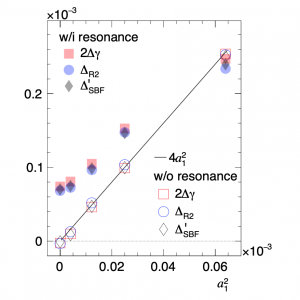
FIG.2 (a) The EBE-AVFD simulations of $2\Delta\gamma_{112}$, $\Delta_{R2}$ and $\Delta'_{\rm SBF}\equiv(\frac{\pi^4}{64M^2}\Delta_{\rm SBF}+\frac{8}{3}v_2\Delta\delta)$ as function of $n_5/s$ in 30-40\% Au+Au collisions at 200 GeV. (b) The same results with the subtraction of the pure-background case vs $(a_{1,+}^2 + a_{1,-}^2 - 2a_{1,+}a_{1,-})$. In comparison, a linear function of $y=x$ is drawn to verify the relation in Eq: O(n_{5}/s) - O(0) = a_{1,+}^2 + a_{1,-}^2 - 2a_{1,+}a_{1,-}.
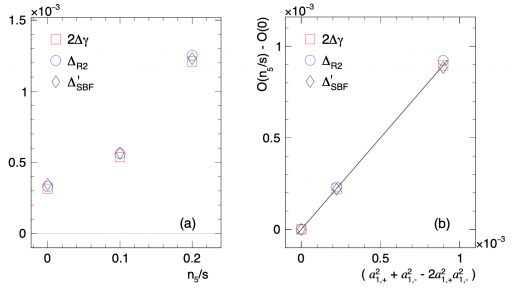
Sensitivity study for isobaric collisions:
TABLE I: The $a_{1,\pm}$ values calculated for the EBE-AVFD events of 30-40\% isobaric collisions at $\sqrt{s_{\rm NN}} = 200$ GeV.

FIG.3 EBE-AVFD calculations of $\gamma_{112}^{\rm OS(SS)}$ (a) and $\Delta \gamma_{112}$ (b) as functions of $n_{5}/s$ for 30-40\% isobaric collisions at $\sqrt{s_{\rm NN}} = 200$ GeV, together with the ratio of $\Delta \gamma_{112}$ (c) between Ru+Ru and Zr+Zr. In panel (c), the $2^{\rm nd}$-order-polynomial fit function illustrates the rising trend starting from (0, 1).
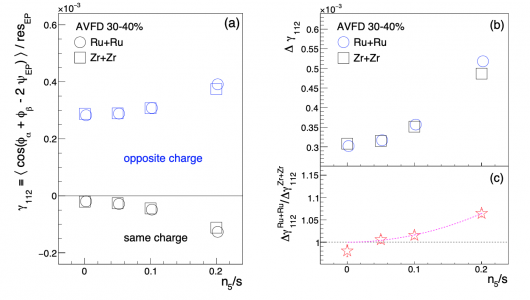
FIG.4 EBE-AVFD calculations of $v_2$ (a) and $\kappa_{112}$ (c) as functions of $n_{5}/s$ for 30-40\% isobaric collisions at $\sqrt{s_{\rm NN}} = 200$ GeV, together with the ratios of $v_2$ (b) and $\kappa_{112}$ (d) between Ru+Ru and Zr+Zr. In panels (d), the $2^{\rm nd}$-order-polynomial fit function illustrates the rising trend starting from (0, 1).
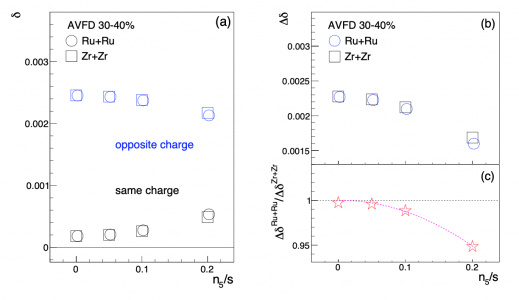
FIG.5 EBE-AVFD calculations of $v_2$ (a) and $\kappa_{112}$ (c) as functions of $n_{5}/s$ for 30-40\% isobaric collisions at $\sqrt{s_{\rm NN}} = 200$ GeV, together with the ratios of $v_2$ (b) and $\kappa_{112}$ (d) between Ru+Ru and Zr+Zr. In panels (d), the $2^{\rm nd}$-order-polynomial fit function illustrates the rising trend starting from (0, 1).
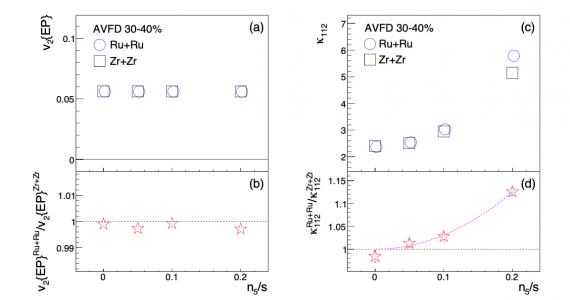
FIG.6 Distributions of $R(\Delta S_2^{''})$ from EBE-AVFD events of 30-40\% Ru+Ru (a) and Zr+Zr (b) at 200 GeV with different $n_{5}/s$ inputs. Panel (c) lists $\sigma^{-1}_{R2}$ vs $n_{5}/s$, extracted from panels (a) and (b), and the $\sigma^{-1}_{R2}$ ratios between Ru+Ru and Zr+Zr are shown in panel (d), where the $2^{\rm nd}$-order-polynomial fit function shows the rising trend starting from (0, 1).
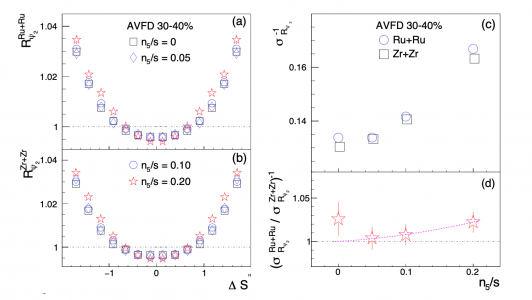
FIG.7 $r_{\mathrm{lab}}$ (a) and $R_{\mathrm{B}}$ (c) as function of $n_{5}/s$ from the EBE-AVFD model for 30-40\% Ru+Ru and Zr+Zr collisions at $\sqrt{s_{\rm NN}} =200$ GeV, with their ratios between Ru+Ru and Zr+Zr in panels (b) and (d), respectively. In panel (b), the $2^{\rm nd}$-order-polynomial fit function demonstrates the rising trend starting from (0, 1).
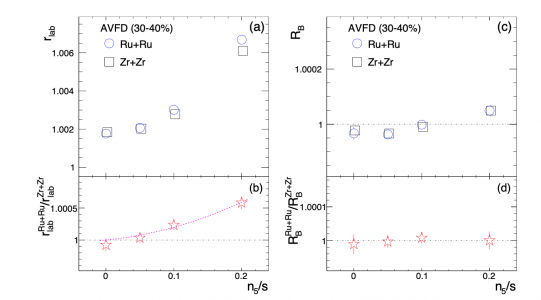
TABLE II: The statistical significance of $(O^{\rm Ru+Ru}/O^{\rm Zr+Zr} -1)$ for different experimental observables. Contrary to other observables, the $\Delta\delta$ ratio expects negative significance values due to the CME signal.
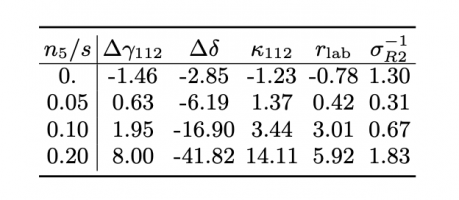
Summary:
Relevant presentations:
Yufu Lin (#Feb 5th, 2021): Follow up on sensitivity study on CME methods (With RP and Same kinematic cuts )
Yufu Lin (#Jan 8th, 2021): Sensitivity test of CME methods with AVFD
Diyu Shen (#Oct 2nd, 2020): Comparison of CME methods
- linyf's blog
- Login or register to post comments
